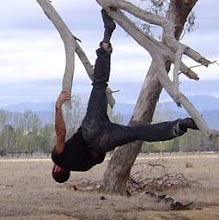We have had more than a week of heat wave and I have an uneasy feeling about the Summer to come. There's been talk of record breaking 50+ degree days on the cards and I'm beginning to rethink some of the garden design to combat climate change as it intensifies more rapidly than most of us could have imagined. This post will concern swales, mulch and shade in a bid to retain moisture in the soil.
Swales are specific to a permaculture garden. I have previously dug spoon drains to take heavy winter rains down to the low point of our quarter acre. The water then escapes down a water board drain. What a waste. I now realise my mistake and am about to turn the spoon drain into a swale that instead follows the contour line through to our new food forest area. This way winter rain will remain where it's needed, absorb deep into the soil and be protected in Summer by the heavy mulching we've been undertaking for the past two years.

Above is the food forest area that we've been preparing for the past 6 months. You can just make out the curving spoon drain, edged by indigenous sedges, that wraps behind the chicken coup and off into a drain. We decided that the raised beds were good for raising seeds however we needed a more random, self-seeding area to tend (or no-tend) in a
Fukuokian manner. As a transition from this form of growing in raised beds to small-scale food forestry, our sowing and plantings have become more random, dispersing seedlings and seeds throughout the garden, enabling us to conduct companion gardening experiments alongside indigenous plants. We have no pest problems to date, but even if we did all can be treated with natural methods. Intense biodiversity, either natural or created through biomimicry such as in a garden or on a farm, will only improve the health of our environments and therefore the food that we eat.

When people rejected natural food and took up refined food instead, society set out on a path towards its own destruction. This is because such food is not the product of true culture. Food is life, and life must not step away from nature. Masanobu Fukuoka, The One-Straw Revolution, p.138

Above is the newly planted Mulberry tree, planted on the nature strip with local grasses, corn and cucumber seedings. The rocks around the seedlings protect their roots from chicken scratching. The Mulberry has been planted to provide fruit and shade equally. Deciduous fruit and nut trees will also be important to conserve water in the soil by providing shade. Many of our leaf vegetables can't be grown in the hot months with so much burning direct sunlight. Currently a potato crop is planted in the food forest area to help break up the clay. They will relish the sun, however they will also demand more and more precious water. They are growing in only 100mm of compost, horse shit and wood-chips. I'm hoping to get some sort of reasonable crop from them. The soil we inherited is very depressing – disturbed gold-fever clay stained with the blood of the Djadjawurrung. Some colonials however are less violent, and in-fact are a godsend, as the shade from our only mature tree, an English Oak, will attest. Onions, broad beans and rhubarb grow under the oak's semi-shade micro-climate along with indigenous banksias, sedges, poas and lomandras.

 Dandelion roots washed and ready for roasting.
Dandelion roots washed and ready for roasting.


























